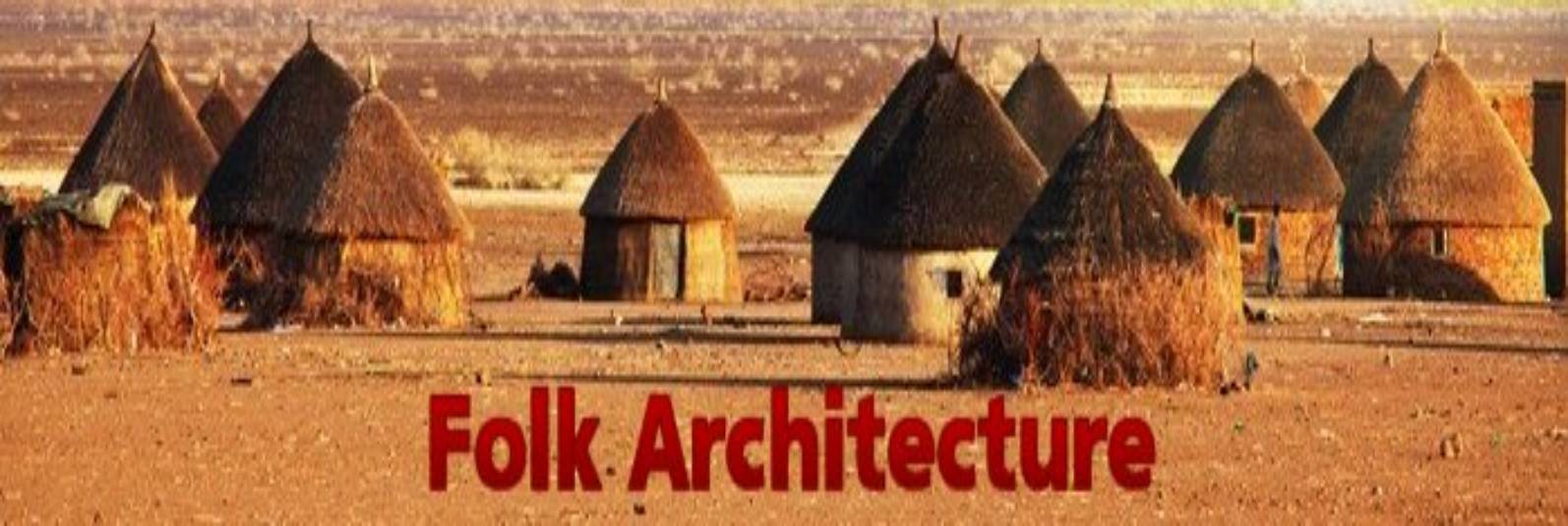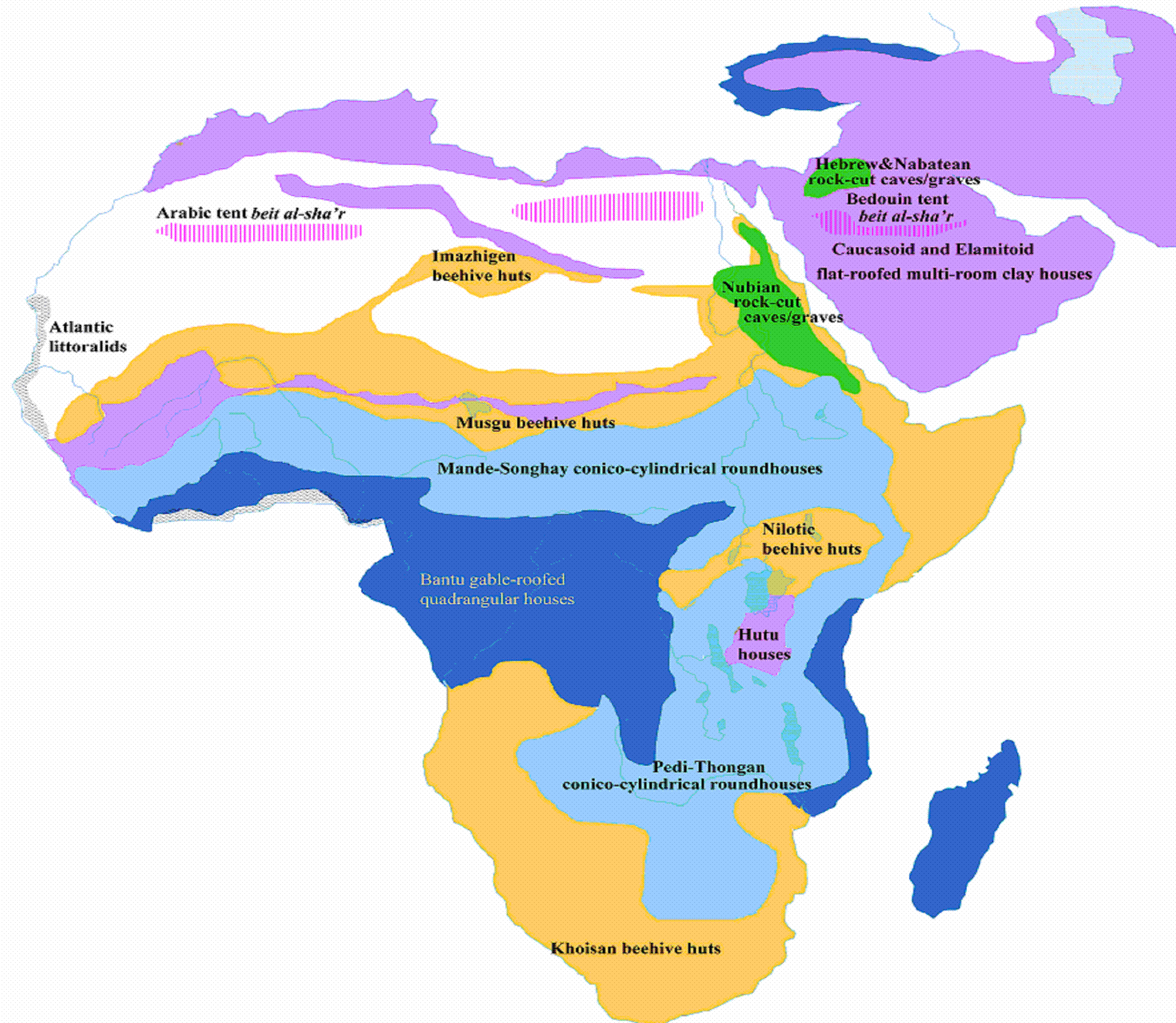|
|
The racial and ethnic
identification cannot be guided only by the present-day phenotype appearance,
its analysis has to trace back archaeological roots, explore geographical
distribution and compare also typological chains in several prehistoric
disciplines. Map 4 demonstrates that Africa is occupied by at least three related dolichocephalous racial stocks
with similar osteology, craniology
and housing: autochthonous African Negrids,
Caucasoid Ethiopids and Nordic Littorids.
Their skeletons show tall stature, platycnemia
betraying terrestial open-air ecotype and upright
gait but share similar traits also in collective life-style, clothing,
architecture and housing. Moreover, they seem to be correlated also by
analogous inclinations to axe-tool making industry, vegetal and
plant-gathering subsistence, rectangular longhouses, matrilocal
endogamous marriage, dowry and theocracy.
Map 4 shows three principal streams of
axe-tool makers, who descended from the African continent but later returned
back to its heart. All factions of Negrids originally
cohabited in large matrilinear families and built
quadrangular timber huts filled by clay. Their shape was roughly similar to
large longhouses inhabited by the Danubian peasants
of the Neolithic Linear Culture or collective house maloca
of the Tupí-Guaraní tribes in Amazonia. The common
denominator of all Negrids consisted in wearing
fringed grass aprons and the custom of grown-up women to go out bare-breasted
in a topless dress. Fringed grass aprons form an indispensable accessory of
clothing in Melanesia, Polynesia and Amazonia. Their design
was clearly discernible also in paintings of ancient Mesopotamian Gutii, ‘Ubaidan peasants and Cretan goddesses. The chief duty of
their females was to bring water in gouged wooden vessels on their head.
Another typical utensil was a head-bench for resting and sleeping.
External influences from Eurasia were
visible in Caucasoid Etiopids and Atlantic Littorids. The Acheulean Ethiopids accomplished an architectural revolution by
replacing wooden logs by clay and rammed pisé
on account of lack wood in arid desert regions. They began to build
multi-cellular many-roomed houses out of sun-dried bricks. They had flat
roofs, firm external walls and few outer windows. In fear of alien intruders,
they were usually accessed on removable ladders from above. Their
architectonic style was favoured by farmers and townsfolk in Ethiopia, Egypt, Libya and Algeria. The
hybrid composition of African Nordids and Caucasoids out of heterogeneous layers should not make us
blind to their specific new peculiarities. Their ethnic heritage shone
through especially in the rites of bull cults and bull fighting. They settled
down in fertile areas along the reaches of water streams but they did not
despise colonising arid areas of oases in deserts, either.
The last but not the least of African
races comes the ethnic group of white-skinned Littoralids
pursuing the western coast of Africa as beachcombers
as far as the South African Cap of Good Hope. The
European Bell-Beaker Folk and African Littoralids
manufactured campaniform pottery with corded
patterns and lived in huts that were reminiscent of the Frisian three-aisled wurt. Their two-pitched roofs were sloping
down to the earth. The mysterious group of Atlantic Littoralids with shell midden
evolved from the Mesolithic Campignian culture
(10,000 BC). They were of Indo-European origin but differed from the Danubian Europids with clear
agricultural dispositions by living as shellfish eaters relishing on
molluscs, snails and frogs. These northern invaders were probably responsible
for the import of the West African sacred double-bitted axe. The ancient
Romans knew it as bipennis, the Greek Minoans called it labrys and Lydians mentioned it as πελεκυς, pelekus. Its true copy was celebrated in
the mythology of African Yoruba people, who worshipped it as a symbol of the
god Sango or Xango.
The early invasion of
white-skinned Nordids into
the African continent can be documented also by archaeological finds. Their
hosts sailed along the western coasts of Portugal, Mauretania, Guinea and Angola as far as South Africa. They belonged to beachcombers classified as Littoralids, built their shelters
on elevated sand-dunes and left behind characteristic heaps of shell midden (kjökkenmöddinger). Their roaming hordes may be denoted as Campignians affiliated to
Frisians and the Mugem
culture in Portugal. The southwest regions of Europe became their secondary homeland and served as the
birthplace of Franco-Swabian
tribes. In the Neolithic they developed a special cultivar of the Beaker-Folk culture with its typical
bell-shaped pottery. It was probably the Portuguese Mugem shell-midden culture that
ensured Frenchmen and Franco-Swabians
the ill repute of frog-eaters. The ceramic morphology of the Spanish Bell-Beaker Folk retained its patterns also on African travels. It
breathed life into the Campagniforme
culture swaying in Guinea and Angola in the Neolithic period. Its spread may be responsible
for a great number of Europoid toponyms and ethnonyms such as Cotonou, Ketou, Brass and Sasso in the Gulf of Guinea. The residual
vestiges of the Bell-Beaker Folk Littoralid’s
colonies can be recognised also in recent ethnic tribes. Bernartzik’s ethnographical survey mentioned them as
hosts of conspicuously white-skinned indigenous tribes on the coasts of Angola.
|
Such intercontinental similarities witness
that consanguine populations maintain genetic inheritance, cultural endurance
and long-range typological stability. Their inner affinity is based on the
common genetic outfit passed as a relay over hundred thousand years. After Negrids pursued the fates of archaic Oldowan
ancestrors they enriched their cultural endowment
by adding Sangoan and Lupembian
innovations. On the Arabian Peninsula they
infiltrated into the northern boreal Asiatic races and their mutual contacts
gave rise to the mixed hybrid race of Acheulean Caucasoids. Caucasoids flooded
the Near East, Anatolia and South
Asia and took part in reforms of Neolithic agriculture.
Their kinsfolk expanded also backwards in the native African continent and
created a new racial variety of Ethiopids. Their
northern mutations included European Neolithic farmers and Campignian Littoralids, who
combed the beaches of Atlantic seacoasts as far as the Gulf of Guinea.
Map 5 adds comparison between rectangular
housing types common to axe-tool cultures of African origin and tent
constructions characteristic of Afro-Asiatic tribes descending from the Near
East. The raids of Afro-Asiatic invaders are assumed to
have created the language families of Semitic,
Berber, Chadic, Cushitic, Egyptian
and Omotic peoples. The Arabic and Bedouin
nomadic camel-breeders lived in irregular marquee tents with several pitches
supported by poles. Bedouins called them beit
al-sha’r, its
Mauritanian form was denoted as tekna and
Tibetan herders knew it as ndrogba.
The Berber Imazhigen originally built huts and
burials mounds resembling cupolar or half-barrel
shaped beehive constructions common among the Maasai
and the Khoisan Khoikhoi.
But they looked like stonemade dome-shaped vaulted cairns,
whereas the cattle-breeding herders in the southern regions of Africa
made them out of boughs and straw. Cushitic
settlers took over the architectonic style of East African rondavels, i.e. the Pedi-Thongan
roundhouses with pointed conical roofs and cylindrical basement. Modern Herero and Damara tribes live
in conical huts with cylindrical understructure but
their Mesolithic progenitors preferred to dwell in rock shelters and articifical rock-hewn-caves. They arrived to South
Africa with the
plantations of Wilton
culture colonists (5000 BC) and sketched petroglyphs
and rock-paintings that are erroneously attributed to Bushmen.
The Word Order in African Languages
Current theories of Afro-Asiatic languages are based
on comparing their lexical substance and pay less attention to phonology,
word-order and syntactic structures. Lexical cognates provide a
good guide in short-range comparison but prove less reliable than short-range
parallels detected by population genetics. Its apparatus enables to trace
chained lineages of chromosomal haplogroups but
fails to furnish links between African and Melanesian Negrids
or between the African Negrillos and the Oceanic Negritos. This is why we find an efficient aid in
long-range parallels detected in popular tribal architecture, clothing
styles, religious magic, ancestral myths and folktale motifs. Good long-range
parallels results are surprisingly obtained also by comparing phonological
repertories, grammatical structures and word-order in different continents.
All descendants of the Olduwan Homo erectus
must have possessed common language paradigms because stray population in
southeast Asia, Oceania and America
preserved their traditional morphology with prefixing classifiers and
phonology with prenasalised stops mb-, nd-, ng-.
Moreover, all axe-tool cultures seem to have maintained the classic
word-order opposed to Altaic agglutination:
|
Construction
|
Mongoloid
|
Indo-European
|
Bantu
|
|
sentence-conjunction
preposition-noun
subject-verb-object
adjective-noun
attribute-noun
numeral-noun
apposition-noun
|
C Cps
Nps
S O V
A N
G N
U Nsg
N P
|
C cr
C
pr Ng
S V O
N Aar (Aar N)
N G
U Npl
P N
|
C cr
C
prN
S V O
crN crA
N G
cN U
P N
|
Table 4. The
typology of word-order structures
To
sum up comparative considerations, it is needful to outline several
long-range generalisations of dolichocephalic
axe-tool manufacturers: (1) Homo
erectus and Oldowan Palaeo-Negrids,
(2) Sangoan Neo-Negrids,
(3) Acheulean Caucasoids
and (5) European Macrolithic Nordids.
This group is opposed to (6) short-sized Lappids,
(7) gracile Ichthyophages
producing Leptolithic flake-tools and (8) giant megafauna hunters. The first two categories belonged to
the black equatorial race that functioned in Africa as
the continental dominant. It absorbed all less populous minorities and
enforced on them its genetic character: melanochroic
skin, the ABO blood group O+, the Y-haplogroup E,
the mtDNA haplogroup L, dolichocranial skull and chamaeorrhinic
nose.
The
primordial unity of axe-tool races lasted more than one million years until
it split into two sections: the sovereign dominance of the black equatorial
race in Africa and
the subdominant vegetation of Acheulean colonists
in Eurasia. In the boreal
regions of Eurasia
equatorial races underwent depigmentation, their
secondary racial dermatic traits changed but their
primary osteal and cranial features still exhibited
genetic continuity. The colour of their skin, hair and eyes acquired lighter
shades, yet their tall robust figure and dolichocephalic
skull survived untouched. Interbreeding and interfertile
contacts with tall Eurasian Dinarids made them lose
characteristic nasal chamaerrhinia and platyrrhinia. Their tall stature grew even taller while
their narrow aquiline nasal profile lowered nasal indices. As a result, three
quarters of Nordic physiognomy are now made up from African axe-tool makers
but one quarter of the newly-acquired genetic endowment is due to the Dinaric neighbourhood.
From Pavel Bělíček: The Differential Analysis of the
Wordwide Human Varieties . Prague 2019. pp. 14-17
|
|


